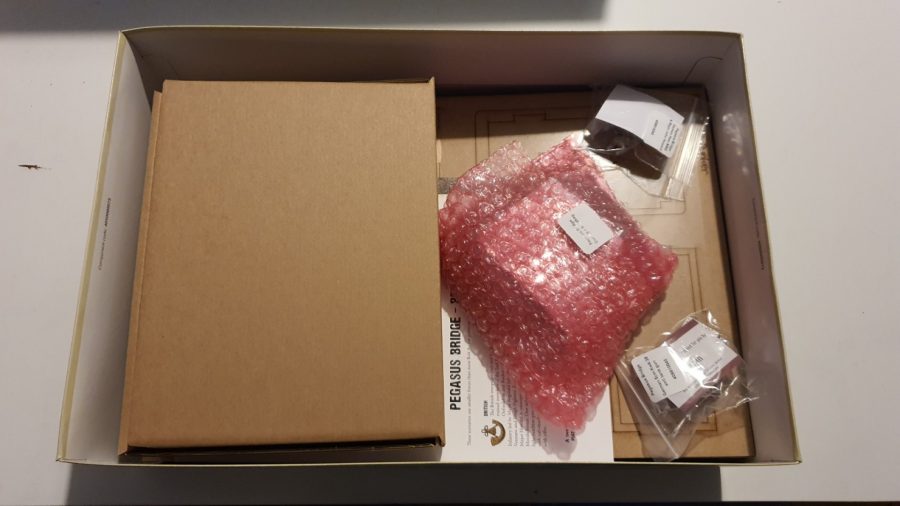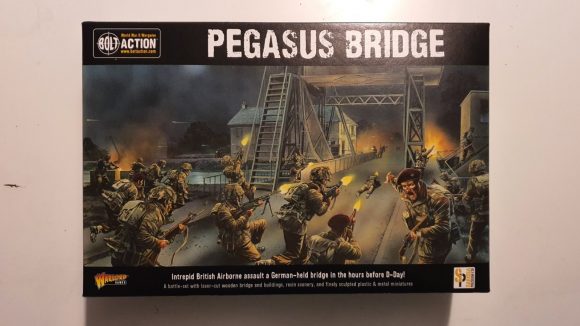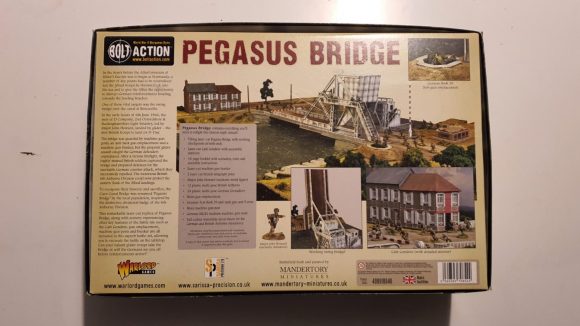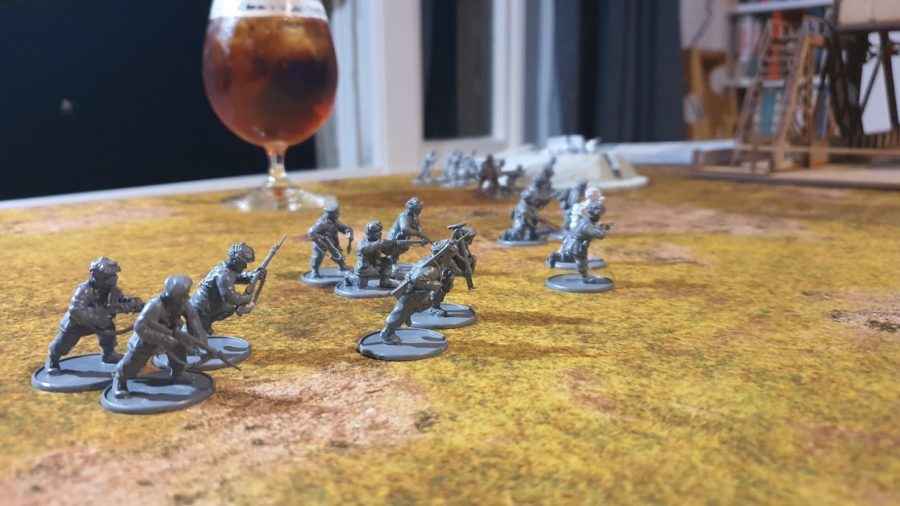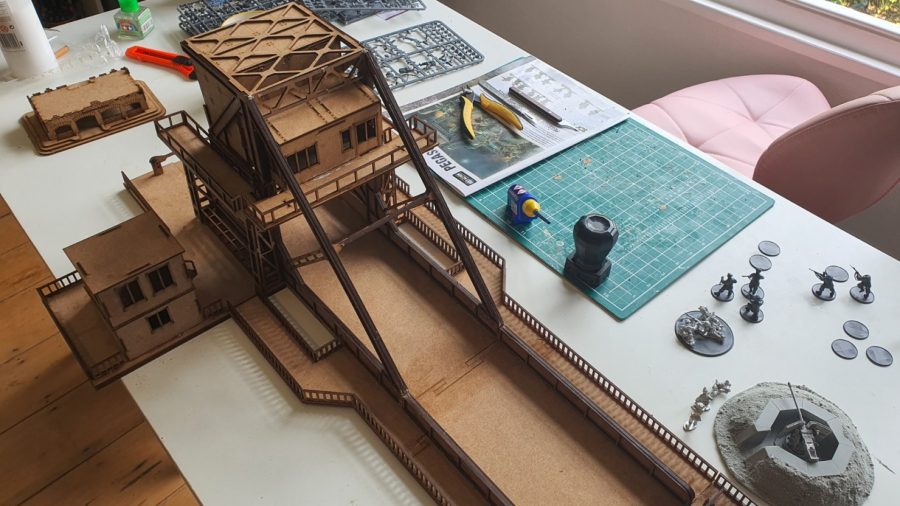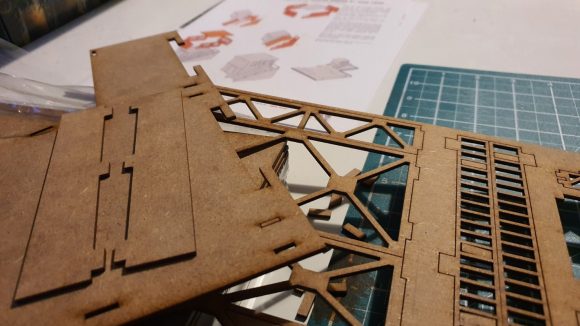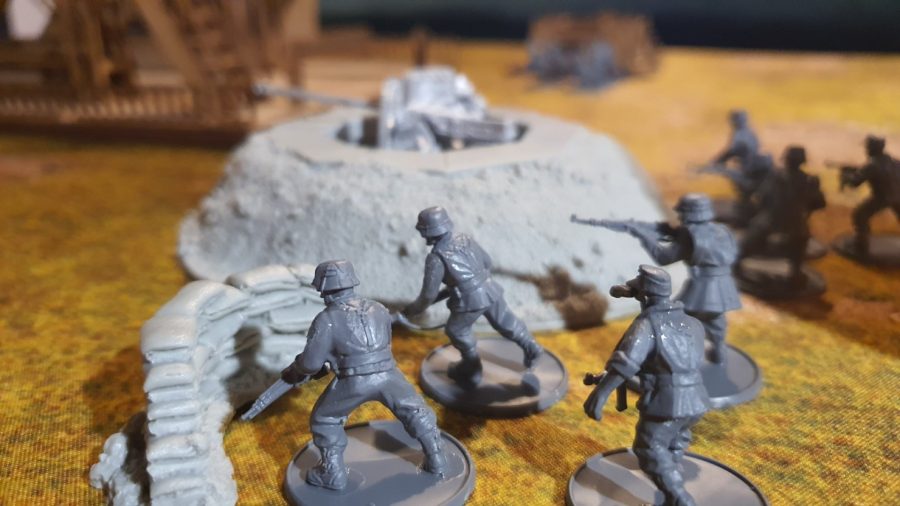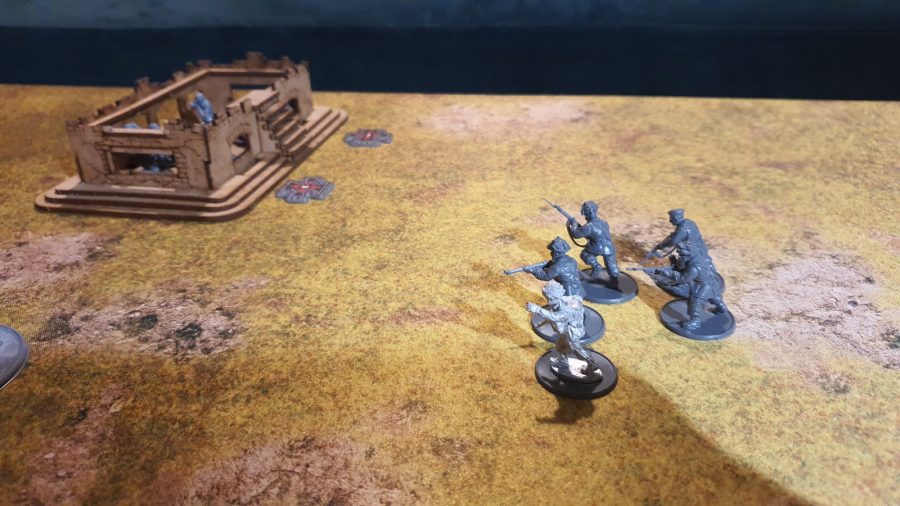Recently, while chatting with a contact at a big miniatures firm about the various delightful boxes of plastic they had coming up, they shared a hypothesis that there are two kinds of miniature wargames: those that are mostly terrain, with some minis thrown in, and those that have it the other way around. If nothing else, my Bolt Action Pegasus Bridge review should demonstrate to you that this box not only belongs in the former category; it’s the mayor of that category. Hell, it deserves its own statue in the town square of that category. Confused? Let me explain.
Pegasus Bridge is a heavy duty $308 / £224 box set for Bolt Action, Warlord Games’ flagship, 28mm scale WWII miniatures wargame. Accurately and honestly marketed by Warlord as a ‘battle box’, rather than any kind of starter set, it’s meant to give you the tools to re-enact a specific, quite famous engagement in the early hours of D-Day, June 6, 1944: the storming of the Bénouville bridge, later renamed ‘Pegasus Bridge’ (more on the history shortly). And, since Warlord kindly sent us a free copy to review, I can tell you all about it.
First things first: this extremely heavy box does not contain a Bolt Action Second Edition rulebook. It doesn’t contain any dice, nor any measuring templates. With 12 British paratroopers and 24 German grenadiers in plastic, plus a metal officer for the Brits, and a metal machine gun team and anti-tank gun crew for the Germans, it doesn’t even contain very many toy soldiers, either, considering the positively terrifying price tag.
What it does contain – and what it feels like the most effort was put into when composing this set – is a very particular collection of high quality terrain designed to replicate the scene of the titular battle with maximum accuracy, including:
- A resin anti-tank gun emplacement
- A resin sandbag barrier machine gun nest
- A laser-cut wood bunker building
- A laser-cut wood replica of the Café Gondrée (read on for details)
- An enormous, highly complicated laser-cut wood replica of the Bénouville bridge
Make no mistake: Bolt Action Pegasus Bridge is not a set for hobby beginners. The eponymous bridge (which, as we’ll see, is no joke to build) makes up such a large slice of the value of the box, and will take up such a large amount of space in your hobby room, that investing in the Pegasus Bridge battle box is a serious decision for any wargamer, even those with a definite penchant for WWII history.
That said, in my time with the box, I found an awful lot to get excited about, and – somewhat to my surprise – did find myself more and more engrossed, as I put together, then played through, its battlefield and first scenario. And that has much to do with the historical backdrop at play.
Pegasus Bridge history
The real-life battle of Pegasus Bridge was a rapid, airborne surprise attack against a German-held bridge over the Caen Canal that began at 00:16 – six hours before the main D-Day landings began. Codenamed ‘Operation Deadstick’, it saw 181 parachutists and glider troops from the British Oxfordshire and Buckinghamshire Light Infantry (a.k.a. Ox and Bucks) land in gliders close to the Bénouville Bridge’s eastern end, before storming the crossing in just ten minutes of fierce fighting.
After taking the bridge, British troops entered the aforesaid Café Gondrée, convinced the French owners they meant no harm (the owners reportedly handed out Champagne to the Tommies in gratitude), and turned it into an aid station. It’s this ‘liberating’ of the Café that’s given Pegasus Bridge most of its fame, since – so the legend goes – it was the very first German-occupied building to be captured during the Normandy landings.
Scale down: Our review of Black Powder Epic Battles: ACW
However, the Ox and Bucks’ relatively small force – led by their now quite legendary commander, Major John Howard – then had to hold out against German counter attacks for hours, until support from the 7th Battalion, Parachute Regiment started to arrive at 3am. The Bénouville Bridge itself was later renamed Pegasus Bridge, after the winged horse insignia of the British airborne troops who took it, and held it, in D-Day’s pivotal opening hours.
It’s exciting, high-energy stuff; and feels quite appropriate to simulate such a blisteringly quick firefight with small, deadly tabletop forces, moving and acting continuously – especially with Bolt Action’s simple, pacy, momentum-building ruleset.
Pegasus Bridge models
In the tabletop, Bolt Action version of Pegasus Bridge, the forces of miniatures are a little more petite than the real thing.
To represent the Brits, you get two identical sprues of Airborne troopers (for a total of 12), with a mixture of Lee Enfield rifles and Sten sub-machine guns, and a metal character model for Major Howard, his arm outstretched in a ‘charge!’ gesture. On the German side, you get 24 plastic Grenadiers across four sprues (armed with K98k and G43 rifles, MP40 sub-machine guns, and StG44 automatic rifles), a three-man metal MG42 medium machine gun team, and a metal KWK 39 anti-tank gun, with its three-man crew. One of the 24 plastic Grenadiers will be a Second Lieutenant to lead the force (teensy weensy Iron Cross optional).
All the plastic figures are multipose, with the advantages and drawbacks that brings: construction is fairly simple, and components easily mixed and matched – but you inevitably end up with lots of unused and duplicate bits. Such is life.
The metal miniatures – despite my reticence after not having worked with metal minis in many a year – have good detail, and a minimum of flash to shave off; generally, they’re pretty drama-free, solid quality sculpts.
Computer revolution: These are the best WW2 games on PC
If you already play Bolt Action, you’ll be well acquainted by now with Warlord’s plastic models – but, for Warhammer veterans and Bolt Action first-timers like me, I can tell you: they’re a breeze to put together, and a lot of fun – except for the mould lines.
Some wargamers don’t care about mould lines on miniatures, and hey, you do you. But if, like me, you obsessively scrape clean every surface on every figure before painting, you’re going to have a little more knife-work with these fellas than with the average modern Warhammer kit. It’s a somewhat academic question, though, because, if you’re a wargamer who doesn’t much enjoy building stuff, this box has a much bigger problem. That’s right: it’s time to talk about the bridge.
Pegasus Bridge terrain
The scale replica of Pegasus Bridge included in this box is monstrously large. It’s roughly two feet wide at its broadest, four feet long, and two feet high, and comes in around ten sheets of laser-cut wood. The components, many of which are incredibly light and fragile once removed from their sheets, are not individually numbered, and there is no proper key.
The written instructions (presented in an unbound sheaf of double-sided A4 sheets) are more akin to old-fashioned flat pack furniture than the brightly-coloured, clearly signposted step-by-step diagrams you find in modern Games Workshop kits. Sub-assemblies are shown in exploded diagrams, but they’re not always very clear, and you’ll probably make some mistakes (I made a lot). Many of the joints need pressure put on them to slot into place, which is nerve-wracking when so many pieces are so eminently breakable. It took me at least 12 hours to complete.
By now, unless you’re a particularly keen wood-modeller, you may be dreading the experience of building this thing, and I haven’t even mentioned the tabs and slots yet. You see, almost every key sub-assembly in this model (like, say, the Gantry Control Room, or the many long, spindly railing pieces) has to be fixed to another part by gluing and pressing wooden tabs through corresponding slots. These slots, however, are such a tight fit that, unless you thoroughly widen them out with modelling files (hard work), the tabs won’t fit. Apply more pressure to force them in, and you’ll end up breaking piece, after piece, after piece.
The other wooden buildings, though subject to the same aggravations, are much simpler, and caused me fewer headaches, while the one-piece resin terrain items (the gun emplacement and MG nest) are well cast and generally lovely.
Sci-fi skirmishes: Check out our Kill Team: Octarius review
Frankly, though, they’re small potatoes in terms of what you’re paying for in this big box – the bridge, as Shakespeare almost wrote, is the thing. And, while the finished product is certainly impressive, I have to say: unlike the minis, I did not have one single ounce of fun building it.
It’s made by wargaming scenery firm Sarissa Precision, and costs $130 / £95 to buy from them separately – nearly half the full price of this box set. When that much of the value of your $300 wargaming purchase is wrapped up in one gigantic, very specific, wooden terrain model, which, for all but the keenest modellers, will be a pain to put together, well… you just really have to want that bridge. A lot.
Pegasus Bridge gameplay and scenarios
Once you’ve scrubbed all the superglue off your thumbs, there is a game in here to play, however. Bolt Action Pegasus Bridge comes with a 15-page booklet, detailing the relevant historical events, the real-life forces of soldiers involved, and the miniatures which represent them, including squad breakdowns, explanations of each unit’s in-game equipment and experience level, and special rules affecting how they act in battle.
This integration between the history and gameplay is important, because Warlord uses some existing Bolt Action special rules to reflect (as far as possible) the characteristics of the real forces involved. In Bolt Action Pegasus Bridge, the British forces are treated as Veterans (increasing their morale and making them tougher to kill), whereas the German Heer are Inexperienced, and have the Shirkers special rule, meaning they have worse base morale and are twice as easy to pin down and rout with concentrated fire. This isn’t far off the history, since the real grenadiers holding Pegasus Bridge were mostly conscripts and POWs from German-occupied parts of the Eastern Front.
What’s more, when the Ox and Bucks get into close combat, their Tough Fighters special rule doubles down on Bolt Action’s already brutal melee system, to make the plucky Brits frighteningly good at wiping out whole squads with just their trusty bayonets.
In the scenario I played (the first of three, simulating the initial British assault on the bridge’s eastern end), these in-built rules made for brilliant thematic gameplay.
Leaping from our Horsa gliders to take the numerically superior Germans unawares, and immediately pinning them with coordinated fire thanks to Major Howard’s order-giving abilities, was honestly a fantastically absorbing wargaming moment.
Telling tales: Why tabletop wargame tell better stories than RPGs
Significantly, though, the Shirkers and Tough Fighters rules are not explained anywhere in the included booklet – you’ll need the full Bolt Action Second Edition rulebook to find out how they work.
The Pegasus Bridge scenario booklet squeezes all Bolt Action’s basic rules onto its back cover, and there’s a free PDF of the core rules on the Warlord site, so yes, you can play with only this box – but you can’t play these scenarios the way they’re meant to be played, and your games will boil down to numbers. Without those special rules, the Brits would get stomped, 99 times out of 100. It just ain’t right.
Who is Bolt Action Pegasus Bridge for?
All of which is to say that this box, on its own, is not the best choice for newcomers to Bolt Action. While the free core rules get you most of the way, the in-box historical scenarios don’t function if you don’t have access to the main rulebook.
And, honestly, even if it did include the full rules, at this extravagant price point, I think most players would get far more out of a box with more miniatures, and more variety of miniatures, especially vehicles – at the cost of all that terrain. They wouldn’t be stuck for choice, either, since Warlord offers various other battle sets, including Bolt Action: The Longest Day, a D-Day box that costs the same as this one, but contains drastically more miniatures, including three vehicles.
Gold Leader: Why X-Wing is the best gateway wargame
For history buff wargamers with an interest in this battle – or, more generally, in exploring some of the less famous engagements of the D-Day landings – then the sheer architectural scale and historical replication delivered by Pegasus Bridge might make this a must buy for you.
And, if that’s you – well, dropping an extra $30 / £21 on that all-important PDF rulebook is probably worthwhile, and I can promise you that the rules are easy as hell to learn; they’re a walk in the park compared to the dice-comparing minutiae of Warhammer 40k, for example.
In the end, where this box excels is in allowing you to play through successive turns of thematically appropriate combat, amid a scene that’s astonishingly visually accurate, right down to photos of the battlefield from the 1940s – and, if that’s what floats your landing craft, then I don’t think I’ve ever seen a better ‘battle box’ for you.
Likewise, if you’re already a serious Bolt Action player, with copious cash to spare, looking for a way to sink several weekends into a well thought out mini-campaign themed around a single, 3-hour battle, then there are definitely some thrills to be had for you here (as long as you like filing down wooden sheets).
For all the rest of us, well, it’s probably a bridge not worth paying the toll for. Don’t worry, though. We’ll get over it.

